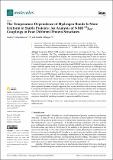| dc.contributor.author | Alexandrescu, Andrei T. | |
| dc.contributor.author | Dregni, Aurelio J. | |
| dc.date.accessioned | 2024-07-16T13:23:42Z | |
| dc.date.available | 2024-07-16T13:23:42Z | |
| dc.date.issued | 2024-06-21 | |
| dc.identifier.issn | 1420-3049 | |
| dc.identifier.uri | https://hdl.handle.net/1721.1/155681 | |
| dc.description.abstract | Long-range HNCO NMR spectra for proteins show crosspeaks due to 1JNC′, 2JNC′, 3JNCγ, and h3JNC′ couplings. The h3JNC′ couplings are transmitted through hydrogen bonds and their sizes are correlated to hydrogen bond lengths. We collected long-range HNCO data at a series of temperatures for four protein structures. P22i and CUS-3i are six-stranded beta-barrel I-domains from phages P22 and CUS-3 that share less than 40% sequence identity. The cis and trans states of the C-terminal domain from pore-forming toxin hemolysin ΙΙ (HlyIIC) arise from the isomerization of a single G404-P405 peptide bond. For P22i and CUS-3i, hydrogen bonds detected by NMR agree with those observed in the corresponding domains from cryoEM structures of the two phages. Hydrogen bond lengths derived from the h3JNC′ couplings, however, are poorly conserved between the distantly related CUS-3i and P22i domains and show differences even between the closely related cis and trans state structures of HlyIIC. This is consistent with hydrogen bond lengths being determined by local differences in structure rather than the overall folding topology. With increasing temperature, hydrogen bonds typically show an apparent increase in length that has been attributed to protein thermal expansion. Some hydrogen bonds are invariant with temperature, however, while others show apparent decreases in length, suggesting they become stabilized with increasing temperature. Considering the data for the three proteins in this study and previously published data for ubiquitin and GB3, lowered protein folding stability and cooperativity corresponds with a larger range of temperature responses for hydrogen bonds. This suggests a partial uncoupling of hydrogen bond energetics from global unfolding cooperativity as protein stability decreases. | en_US |
| dc.publisher | MDPI AG | en_US |
| dc.relation.isversionof | 10.3390/molecules29132950 | en_US |
| dc.rights | Creative Commons Attribution | en_US |
| dc.rights.uri | https://creativecommons.org/licenses/by/4.0/ | en_US |
| dc.source | Multidisciplinary Digital Publishing Institute | en_US |
| dc.title | The Temperature Dependence of Hydrogen Bonds Is More Uniform in Stable Proteins: An Analysis of NMR h3JNC′ Couplings in Four Different Protein Structures | en_US |
| dc.type | Article | en_US |
| dc.identifier.citation | Alexandrescu, A.T.; Dregni, A.J. The Temperature Dependence of Hydrogen Bonds Is More Uniform in Stable Proteins: An Analysis of NMR h3JNC′ Couplings in Four Different Protein Structures. Molecules 2024, 29, 2950. | en_US |
| dc.contributor.department | Massachusetts Institute of Technology. Department of Chemistry | |
| dc.relation.journal | Molecules | en_US |
| dc.identifier.mitlicense | PUBLISHER_CC | |
| dc.eprint.version | Final published version | en_US |
| dc.type.uri | http://purl.org/eprint/type/JournalArticle | en_US |
| eprint.status | http://purl.org/eprint/status/PeerReviewed | en_US |
| dc.date.updated | 2024-07-12T12:42:18Z | |
| dspace.date.submission | 2024-07-12T12:42:18Z | |
| mit.journal.volume | 29 | en_US |
| mit.journal.issue | 13 | en_US |
| mit.license | PUBLISHER_CC | |
| mit.metadata.status | Authority Work and Publication Information Needed | en_US |
